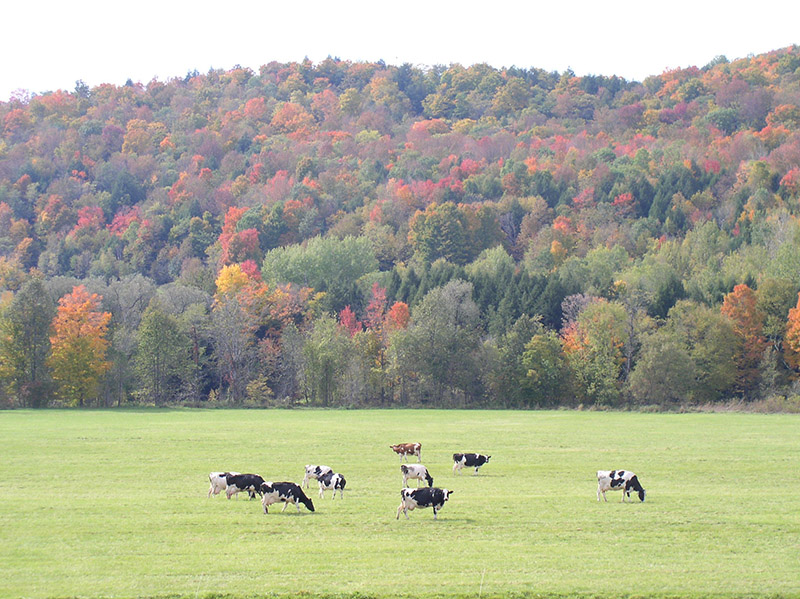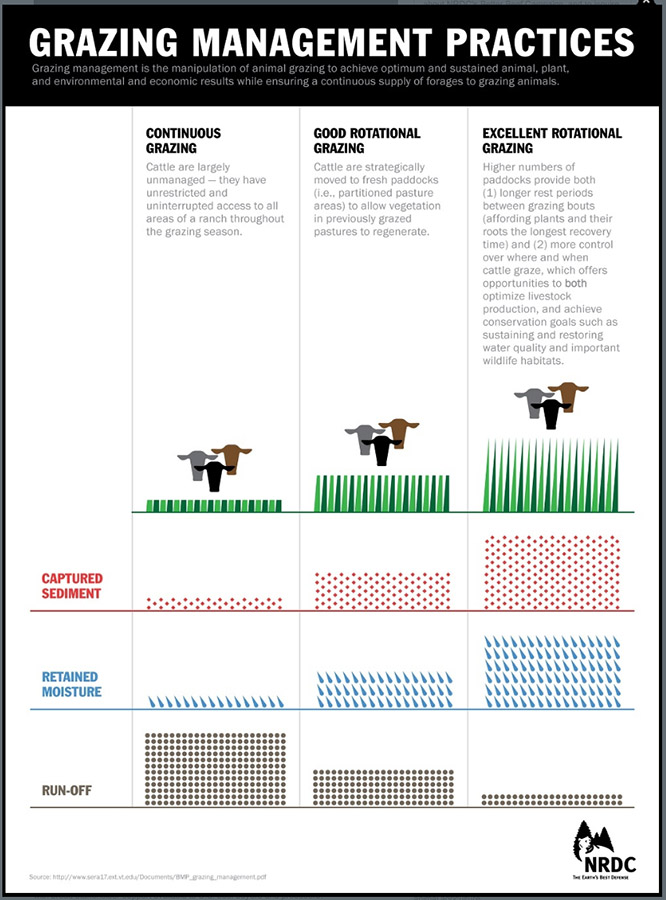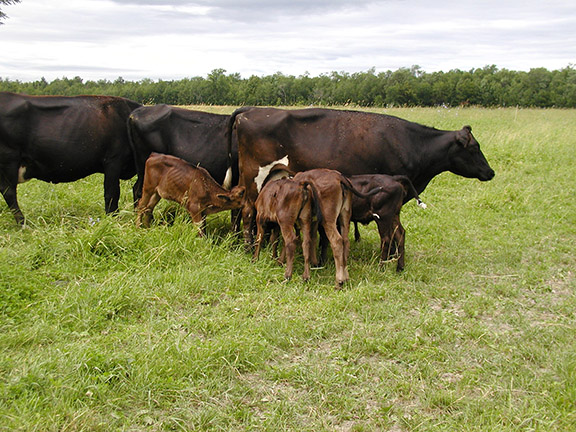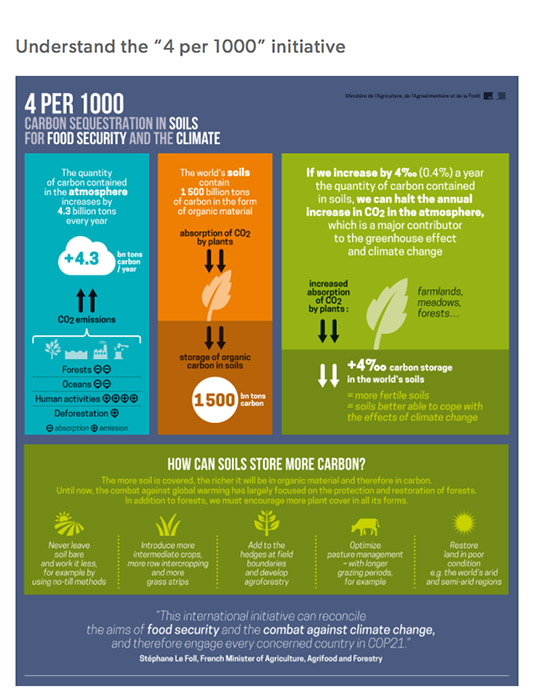| Working with Vermont’s Pastures | |||||||
| by Amy Brooks Thornton | |||||||
 |
|||||||
It started with a cow raised on the expansive sloping fields of Sparrow Farm in East Montpelier. Last year, while running along the dirt road bordering the fields where the herd grazed, the sharp and muscular Worcester Range quietly dominating the backdrop, I wondered how this spectacular and locally famous view of cows on pasture rimmed by wilderness is an aesthetic to which we humans have become trained over thousands of years to appreciate. Herds of animals on pasture and the untamed wild. Domesticated food in nature. The scene resonates deep within us; we replicate it in paintings, photos, films. I’ve never seen a postcard or painting of an animal feedlot: whether or not such feedlots can solve world hunger, such an image could only be one of dystopia. I saw a truck pulled over to the side of the road, near the cows, and stopped my run to talk to one of the owners of the herd, Adam Lane. He had an extra side to sell, and I eagerly committed—nothing like having a 18-year-old, six foot three inch athletic son to feed. And I had heard enough about the benefits of pasture-raised meat to intrigue me. My growing knowledge of the climate impact of beef production had threatened to abort any of my future purchases of meat. But I had yet to learn commonly cited numbers comparing the lifespans of feedlot cattle to pasture-raised-and-fed or grazed beef cattle—a big factor in the climate impact calculations due to methane production.
The biggest two contributors to the climate impact of beef cattle are the energy consumed to grow feed (cropping) and house the animals and the methane released by the cattle over their lifespan. Those supporting concentrated animal feedlot operations (CAFOs), which is how most of our meat is raised, argue that the climate impact of CAFO cattle and grazed cattle is the same due to methane, the highly heat-trapping greenhouse gas that cows produce when they excrete. According to the Environmental Protection Agency, methane has 25 times more global-warming potential than carbon dioxide (CO2). The argument goes that while CAFO beef cattle production is very energy intensive—the necessary cropping for feed and animal housing releases abundant amounts of CO2 into the atmosphere—grain-fed cattle, which have only a 12-month lifespan, produce lower methane emissions than pasture-raised animals, which are longer lived. Grazed cattle, although they require much less energy to raise, are frequently cited in scientific research papers as having a much longer lifespan of up to three-plus years, thus excreting and emitting more methane. But, according to a growing number of agroecologists and farmer-scientists, including Sarah Flack, from Fairfield, Vermont, a consultant specializing in grass-based and organic livestock production and author of the forthcoming book The Art and Science of Grazing (Chelsea Green, June 2016), farmers can finish even 100 percent grazed beef in two years. To do so, the pasture needs to be lush with species diversity, the soil fertile with high organic matter, and the cattle bred to graze on pasture and moved across pastures frequently. The potential reduced two-year lifespan of grazed cattle, which would significantly decrease methane emissions, coupled with the positive impact of well-managed pastures, which can sequester CO2, arguably makes pasture-raised-and-fed cattle a lot better for the climate than CAFO. “The nature of the beast with agriculture is you are throwing things out of balance. You have to figure out a way to help it balance itself out. To me that’s what pastures do,” says Kimberly Hagen, grazing specialist for the University of Vermont (UVM) Center for Sustainable Agriculture. “I do see farms that just let the cows out . . . That doesn’t work. The old industrial agricultural model has had some pretty serious consequences.” Hagen, who also raises sheep for meat and rugs, says Vermont’s sheep industry in the 1800s deforested mountaintops, exposed fragile forest soils to weather and consequent erosion, and removed life-supporting habitat for forest-loving beasts and plants. But, the sheep are not to blame, says Jenn Colby, Pasture Program coordinator at the UVM Center for Sustainable Agriculture and sheep farmer. “The deforestation and horrible erosion due to overstocking and continuous grazing,” Colby says, was “a very different beast than managed rotational grazing. It’s easy to make a blanket statement that it’s the fault of the sheep.” Overstocking and continuous grazing in which too many cows are turned out in one fenced pasture to eat down the forage to a point of little or no return can create compacted soils and even desertification—when land becomes arid and loses its ability to retain water, vegetation, and wildlife. Some western rangeland is close to desertification, and old farm pastures in Vermont are often compacted with low fertility. Compact spoils don’t absorb nutrients and lose soil in heavy rain events. The State of Vermont’s Watershed Management Division says that “Phosphorus is one of the nutrient pollutants found in runoff and arguably the greatest threat to clean water in Lake Champlain. . . . Too much phosphorus pollution stimulates excessive growth of algae [which can] turn Lake Champlain water green, and even can be toxic to pets and people.”
“There is quite a science” to good pasture management, Hagen says. “It’s a constant conversation between yourself, your land, and your animals. You have to teach yourself how to observe. We rely so much on technology to figure things out for us. I try to convince farmers—to really do this you’ve got to get off the tractor and get down on the ground, pay attention to the forages, and watch your animals and see how they react to grazing on it.” Managed pasture or management intensive grazing (MiG) is a brilliant and ancient solution. Used by nomadic herdsmen throughout the world and in Britain and Europe beginning over 500 years ago, management-intensive grazing encourages livestock movement through pasture or range land, allowing the forage plants to rest and replenish. In current well-managed grazing practices, farmer-cum-scientists shepherd their livestock over grassland soils, careful observing and measuring the cycle of and interactions on their farm between animals, pasture plants, soil, and water. The on-the-ground process allows farmers to “take cues” Hagen says, and “figure out what they’ll do with their pastures and how . . . to add amendments.” The quality of pastureland and the management practices of the farmer determine how often to move the herd—every two or three days or two to three times daily. The movement through the fields lets the pasture plants recover and persist from year to year. It also distributes animal waste (nitrogen, phosphorous, potassium, and large numbers of microrganisms) into the soil, which increases soil fertility and produces higher forage yield. Sometimes farmers plant their pastures with a mix of clovers and legumes, which “fix” nitrogen in the soil, making it available for other species to thrive. The resulting pasture is diverse in plant species, many of which persist from year to year, removing the expense and labor of reseeding, as well as habitat for wildlife, birds, and insects, such as declining native bees. The soils beneath the green are high in organic matter, full of microbial life, and spongelike with myriad pockets of air. In a “a high functioning pasture situation,” Hagen says, “you see the birds, the insects, the water flowing through it, the manures breaking down nicely.”
Moving cattle so frequently, sometimes setting up portable fencing each time or spending long days setting it up early in the season, seems a labor of love—for the climate or for the cows, but not for the pocket. Yet on UVM’s “Across the Fence Program,” Bill Murphy, Professor Emeritus, University of Vermont Plant and Soil Science, says it’s not. Murphy grew up on a dairy farm and witnessed the 15-hour days of raising grain-fed cattle year-round. Why choose winter feeding all year when Vermont has six to seven good months of grazing, the cows feed themselves, and the farmer’s work takes only two to three hours daily?, Murphy asks. “It’s a different pace than what you would have if you were doing crop farming. A much slower pace once you get your pastures going,” says Hagen. “You can really enjoy your animals and your landscape because you are out tending to it.” Surveys by UVM Extension of Vermont farmers who have pasture-intensive programs reveal that the farmers’ quality of life is much higher. “I went to a pasture walk in the ’80s with a farmer,” Hagen recalls. “He never had time to be with his kids or his family. He said: ‘I’m not going to do this growing corn, I’m going to make pasture and have the animals spread their own manure and feed themselves.’ He changed the quality of his life. He had time to be with his family.” Murphy also says grazing is much less expensive than grain-fed, confined operations due to the substantially decreased cost for machinery, fuel, facilities, and hired help. Tom Kriegl, farm financial analyst for the University of Wisconsin Center for Dairy Profitability, compared net dairy farm income on Wisconsin and New York grazing and confinement farms over six years, from 2000 through 2005. Although there was a wide range of profitability, he found that the farms that used grazing—harvesting at least 30 percent of grazing season forage from grazing and providing fresh pasture at least once every three days—had higher net income than their confinement counterparts.
If you’re an organic farmer, you’re a pasture farmer. The USDA’s “very high and prescriptive” organic standards, Flack says, require that animals over six months of age get an average of at least 30 percent of their dry matter intake from pasture during the grazing season. Flack works with both nonorganic and organic dairy, beef, and sheep farmers. Her current work includes helping dairy farmers who want to convert from conventional to organic to set up new grazing systems. Organic milk is attractive to farmers because of the volatility of conventional milk prices, which makes it hard for dairy farmers to plan ahead. They have “no control over the pricing,” says Flack. Organic pricing tends to be more stable or increase, which allows farmers to establish a long term financial plan. “Combine the [more stable prices] with lower feed costs by adding pasture into the ration during grazing season and [the farm] becomes financially viable. . . . The majority of my clients are improving or setting up grass-based systems to improve their bottom line or stay in business,” says Flack. The markets for organic and, increasingly, pasture-raised-and-fed dairy are growing. It’s important for farmers to understand the market demand and label recognition, Flack says. And for consumers to understand not only what the labeling means but also the effort it takes for farmers to conform to the many different label standards. Depending on the market, some farmers decide to obtain certification to several different standards, including organic, one of the animal welfare standards, non–GMO, or grassfed. “Every time you send an auditor out to a farm, you are using up that farmer’s valuable time. It would be better to streamline the process so it’s not so expensive and time consuming for the farmers,” she says.
A good pasture with fertile soil and healthy plants capture, or sequester, carbon from the air into the soil. New research suggests that by increasing the health of our pastures, we can reduce our “legacy load” of CO2 already released in the atmosphere. Professor Mahdi Al-Kaisi of Iowa State University (ISU) explains in an ISU Integrated Crop Management article that “pasture is a natural carbon storage facility that can maximize carbon storage due to the stability of the [grasses and pasture plants]. . . . Pasture practices that encourage carbon storage can . . . restore environmental quality by reducing atmospheric levels of carbon dioxide, and foster long-term sustainability.” Colby explains that very heavily tilled soils have about 1 to 2 percent organic matter, or very little carbon. In continuously grazed pastures where the plant roots are not allowed to grow much, you’d find 2 to 4 percent organic matter and more carbon. But with really well-managed grazing, 5 to 6 percent up to 9 to 11 percent matter exists in the soil. New Mexico State University molecular biologist David C. Johnson studied how best to capture atmospheric CO2 and return it to the soil, while improving agricultural systems. With his microbially diverse compost, he encouraged fungal-dominated soils, which in turn increased plant yield substantially and led to increased carbon sequestration. “It turns out that our farmers are the key to successfully reducing greenhouse gases within a sustainable agricultural system,” Johnson says in an interview with NMSU’s News Center. More carbon in the soil is less carbon in the air, and good for the planet. Flack turns the equation around: what is best for the farm is best for the climate. “Every farm I work with we include the impact of climate change on our farm plan. Climate change is having a significant challenging impact on all of the farms I work with. . . . It’s very important to look at how climate change in that region is impacting that farm and create resiliency in the farm ecosystem to withstand high rain events or long periods of no rainfall, high wind storms, temperature extremes, saturated soils, dry soils.” Although, “a lot of [farmers] are passionate about the whole planetary ecosystem [they often need to focus on] grazing management to improve their own farm before they have the available cash flow to think about the bigger picture.” Ironically, “due to climate change shift we [Vermont] are going to extend our grass-growing season,” says Colby. “We’ll be able to let our livestock graze longer, and we may be more profitable and successful.” Healthy pastures act like a sponge, soaking up water and nutrients. “The more carbon we can move out of the atmosphere and put in the soil, the more productive our farms are, the cleaner our water is,” Colby says. Flack adds that, “If we were able to convert…or reduce…the land used to grow continuous crops of corn particularly where it’s not getting a fall cover crop over to permanent perennial pastures we would significantly decrease the amount of soil loss and, therefore, phosphorous into Lake Champlain.” Because healthy pastures hold soil they are resilient to extreme climate events unlike tilled cropland. Doug Flack, Sarah Flacks father, is co-owner with his wife Barbara of the biodynamic and organic Flack Family Farms in Enosburg, Vermont in which he uses MiG grazing for his dairy cows. On UVM’s Across the Fence Flack tells of the resilience of his pastures last summer when Vermont recorded record rainfalls; 19 inches, according to Flack, fell on and were absorbed happily by his pastures. His vegetable fields fared much worse. “We do need to create the ability to grow protein for our bodies,” Colby says. It’s a highly dissonant thought in today’s anti-meat culture, but, until we perfect no-till crop growing, could growing pasture-raised-and-fed meat and dairy help fulfill our dietary needs as well as be more resilient to climate change than crops on tilled land? Recent discoveries about conjugated linoleic acids (CLAs) link their anti-inflammatory properties to reduction in allergic reaction to food and symptoms of heart disease, and prevention of cancer and immune system disorders, writes Marion Nestle in What to Eat. Beneficial conjugated linoleic acids—the product of ruminants’ bacterial conversion of fatty acids—are at least two times higher in meat from pasture-fed cattle and two and a half times higher in milk from pasture-fed cows. Cattle eating corn and soybeans have reduced bacteria in their rumens resulting in decreased ability to convert fatty acids to CLAs. Research by Dr. Loren Cordain, Professor Emeritus at Colorado State University in Health and Exercise Science and creator of the Paleo Diet, and others found that pasture-raised and free-range cattle have lower saturated fats and healthier ratios of n-6 to n-3 polyunsaturated fats (PUFAs) than industrial meat, closer to the meat we ate as hunter-gatherers. The balance of dietary n−6 and n−3 PUFAs is critical in preventing the risk of chronic disease and promoting health. In comparison, CAFO meat has unhealthy triglycerol accumulation and high saturated fatty acids (SFAs) which contribute to a wide variety of chronic diseases. It’s important to note that unless you are raising your own livestock or know your farmer, you will not know if the meat on your plate was from a pasture-fed cow, and how much pasture that cow ate, unless it’s certified through a reliable certification process. Pastures in farmland are increasing in Vermont, according to the latest USDA data. Of all of Vermont farmland, pasture acreage increased from 7 to 11 percent between 2002 and 2012, a total of 140,000 acres. The number of farms with at least some permanent pastures increased from 36 to 60 percent over the last 20 years. The question remains, How much unused pasture is available for the growth of pasture-raised livestock farming? In 2007 Vermont had 308,000 acres of total pastureland not including hay land, (a loss of 137,000 acres since 1982). In the same year, only 45 percent of that pasture was in farmland, and even less, 14 percent, was prime pastureland according to the 2007 National Resources Inventory and the USDA Economic Research Service. In contrast, Vermont forestland accounted for over four million acres. “We have a tremendous capacity to increase the amount of acreage in perennial grasslands under good grazing management,” says Flack. “We have a huge amount of land in the state which is best suited for perennial diverse pasture. All of that land should just stay in well managed, highly diverse, pasture.” In Vermont “we are really well adapted to growing grass,” says Colby. “We have a lot of water, we have really good productive soils, we are in a unique position to grow a lot of grass for 6 to 7 months out of the year…It doesn’t take much water to raise a pasture animal in Vermont. Very little water needed when they are on pasture. However, “The challenge is that the farms are becoming increasingly fragmented,” says Flack. Farmers are “often faced with not having enough land, particularly for the dairy farms, [which need] land that is within easy walking distance to the farm. [This] limits herd size,” says Flack. “There are farm land bases where we can’t figure out how to come up with a sufficient income for one person to stay home to [farm] because of the fragmentation due to driveways and houses,,” says Flack. Locating solar panels so they don’t fragment and adversely impact the grazing and cropping of the land is also essential. Beef cattle or sheep operations are more flexible. “You can operate different group of animals on different pieces of land. But, because they are using fragmented land they have to truck their animals from one piece of land to another instead of letting them walk,’ says Flack. “It makes me crazy that a housing development or bunch of solar panels is planted in the middle of prime farmland. It’s no longer one contiguous farm. Now [it’s] two mini farms,” says Flack.
Since maple sugaring and bio fuel production in Vermont put humans and machinery into the woods already, why not create a multifunctional landscape and use the land for livestock also? Silvopasturing, the mutually beneficial practice of combining forestry with about a 35% canopy, and grazing domesticated animals, could make us more resilient, Colby says. “I do not presume that every spot should be grazed. We have some really sensitive areas that do need to be protected.” Kevin Kaija, Conservation Agronomist for the Natural Resources Conservation Service in Vermont says that the Vermont biofuels producers are removing pine and leaving hardwoods from poor growth forests, which are often overgrown pastureland. Kaija says these areas could be an opportunity for silvopasturing as long as the clearing is “done judiciously, not on shallow soils” and doesn’t fragment the forest corridors. If the concern is food supply and enough land to feed ourselves, not only do we have thousands of viable pastureland acres, we’ve got room to raise meat in our own backyards. Colby currently has a flock of 17 Katahdin Hair Sheep, meat animals, on eight acres in the town of Randolph, Vermont. Her house sits on two acres which she combines with an arrangement with the town to pasture her sheep on an additional six of theirs. When a grant Randolph used to clear town pasture ran out, Colby’s sheep came to the rescue keeping it open and munching a variety of invasive species to oblivion. Gone are the gas guzzling weed whackers and lawnmowers. Colby, who spends about twenty minutes a day tending them when she returns from work says they “require very little work, don’t require docking their tails or shearing, healthy with even a parasite load and easy lambers. Often they have twins and triplets with zero assistance from me.” Plus, it maintains good neighbor relations; if they get out, unlike pigs who make a mess of gardens, sheep “are cute.” There’s a “huge future for lamb meat in Vermont,” says Colby. And, “There are some new exciting opportunities for wool in Vermont” such as wool insulation. Farms often process and marketing their wool online. Currently, Vermont lacks enough wool processing facilities and often farms are too small to match the size of the spinnery, and have to combine their wool with other farmers. We’ve learned from the past that pasturing dry climate loving Merino sheep in Vermont’s wet climate and on its fragile mountain soils is labor intensive and environmentally devastating. But if we raised hardy Northern European pasture-loving breeds on land meant for pasture with the environment in mind as well as our pockets, “You can practically ignore them,” says Hagen. “They can eat the crappiest forages, and six months later you’ve got enough meat (per animal) for two people for a year. Plenty of meat,” says Hagen. Colby, Flack, and Hagen, are all deeply dedicated to the well-being of farming and the environment and see them as inextricably interdependent. Vermont’s pasture can serve both. “These farmers I work with are my people,” says Colby. “I feel we are kindred spirits we all have the same ‘illness’ together…I need to have animals in my life. Pasture has just been the culmination.” My son returned from college a few days ago and finished off a pound of ground meat from the black Angus cow I’d driven past this summer. I was sad for the cow, awed by the landscape, and encouraged by the scientists and farmers researching and producing sustainable food for our table. It’s what we do in Vermont and why we are here. “If we didn’t have livestock keeping this land open Vermont would look like New Hampshire,” Hagen says candidly. “A lot of people like that open working landscape.”
|
|||||||
| Amy Brooks Thornton, founder of Pacem School, Montpelier, is a graduate student at Harvard University, studying lifestyle medicine and personal sustainability.
|
|||||||





